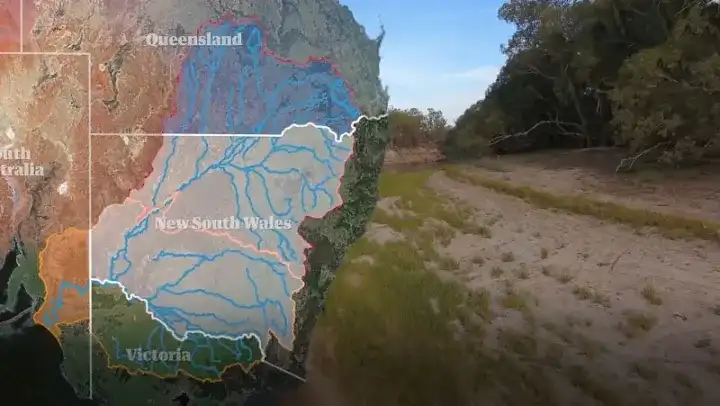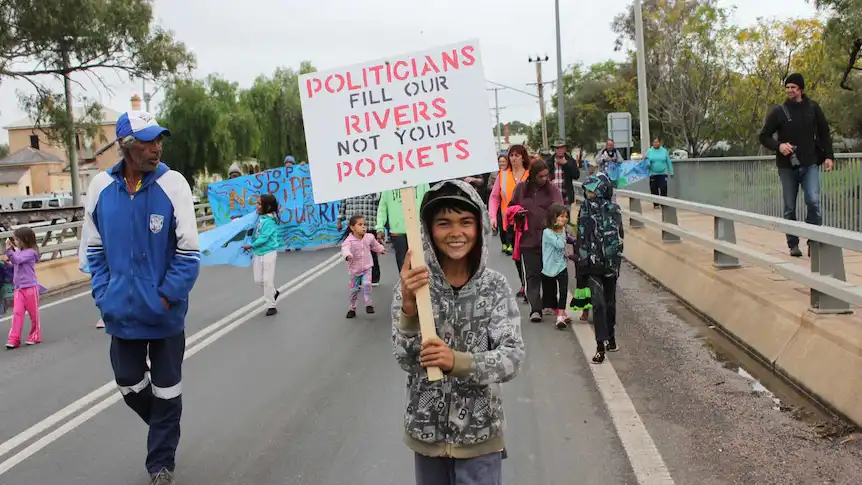The Murray-Darling Basin is a large water catchment spanning southern Queensland, eastern South Australia and the majority of inland Victoria and New South Wales. It has been inhabited for over 50,000 years and is home to more than 40 different First Nations. It is also home to 40% of Australia’s farms, playing a critical role in the global food network. Despite its environmental, cultural and economic importance, the Murray-Darling is dying.
The catchment is under attack from all sides and its individual components are feeling the heat. From the enormous fish deaths and algae blooms in the recent drought, to chemical runoff from agriculture and mining, to the decimation of wetlands, this region has taken a serious beating. For example, the Murray-Darling River in Queensland has lost 70% of its wetlands over the last century. Waterbird populations have declined by more than 70%, according to a 30-year UNSW study. The Murray-Darling shows all the symptoms of a disease, but what is the root cause?
Politicians will often refer to devastating droughts as “natural events”, more savvy ones will put the blame solely on the effects of climate change. Despite the political spin, the answer is far more complicated. Pumping water to irrigate fields, Roundup runoff, and dams impeding natural water flow are clearly not natural processes, nor are they consequences of climate change. These man-made things were introduced and maintained with a drive to increase profits.
The introduction of these harmful processes came with European colonisation. For millennia, First Nations people had been influencing the natural world to better suit human life, but the encroaching colonial rulers lacked their understanding of the region's natural processes.
Governments invested in dams, weirs, and other water storage solutions from 1918 to 1970 in order to provide consistent water supplies to permanent settlements and farms. This had the unintended side effect of disrupting the natural flow of rivers, resulting in the drying up of wetlands, the natural water storage facilities of the basin. Dams can provide medium-term relief for those needing reliable water but in the long term they reduce rivers’ capacity to hold water naturally.
For the majority of European settlement, water was tied to land deeds. The more land you had, the more water you could use. This changed during the 80’s and 90’s as water licences were divorced from land deeds and an open water trading system was introduced. Today, agribusiness Webster Ltd and cotton farmer Peter Harris own 70% of the private water deeds in the Murray-Darling, creating a water monopoly. Treating water as a commodity on the stock exchange has led to its gradual concentration into fewer hands, as is the tendency with capitalism. This water market has opened room for greater collusion between the state and capital.
Another change was the Murray-Darling Basin Plan, introduced during the devastating Millenium drought in 2007. The plan was meant to regulate the market and implement government buybacks of water to increase environmental flows. The plan was slow to be implemented and, 15 years on, hasn't lived up to its stated goals. The plan was bogged down in drawn out community consultation, attacked in the corporate press and interfered with by the Liberal-National coalition. Criticism came from a $34 million deal to buy overflow water rights from Tandou Station, owned by Webster Ltd., during a drought. This purchase happened during a drought where there was no overflow, $32 million for hypothetical water. After the Coalition defeated Labor in 2013, the plan changed from a sluggish failure to a corrupt farce.
During the last coalition government, there was blatant corruption in the implementation of the plan, mainly facilitated through the Nationals. Tandou Station got another sweet deal with Baranaby Joyce, arranging another water rights purchase for $78 million. This purchase was over double the market price for water licences. Webster Ltd., with land holdings all over the basin, moved their irrigation projects into the estuaries, draining water before it even reached the larger rivers.
The new Labor government has promised to reintroduce the basin plan in all its theoretical glory. Community groups have welcomed the reintroduction, but can the new government deliver? There is a 12-month community consultation (government-speak for meeting with concerned big businesses) period for the governments to negotiate how the plan will be implemented. Here, Labor will find ways to compromise with big agribusiness so that nothing gets worse but nothing gets better, following Labor’s 50 year old playbook. Keep in mind that it was Labor who introduced the water market during Hawke and Keating’s neoliberal reforms. Community groups need to keep a close eye on these negotiations; there will almost certainly be a lot of political manoeuvring.
The headlines paint a picture of politics in the Murray-Darling as a game open only to the ruling class. However, as with any political decision, working-class people can and do make their voices heard.
There has been a great deal of grassroots activism to stop agribusiness from destroying the basin. Local First Nations peoples typically lead this activism. A series of bridge blockades on the Barrier Highway have been held to raise awareness of the destruction, the most recent being in 2020. There was also the 2019 Yaama Ngunna Baaka Corroboree, which took people from across the continent to visit the southern section of the Darling. There, people from all walks of life learned about the problems facing the basin, its rich cultural heritage, and strategies to fix the damage. These grassroots organisations have the potential to save the basin if they can harness popular power to put pressure on the government to act.
The Murray-Darling is in serious peril. Capitalist mismanagement of water resources has resulted in the decline of the basins' complex ecosystems. Government conservation efforts have ranged from inadequately slow to completely corrupt. Grassroot organisations pushing for rational water usage in the basin can’t rely on the new Labor administration to carry out conservation measures. It is up to these organisations to help create working class power to put pressure on the government.

